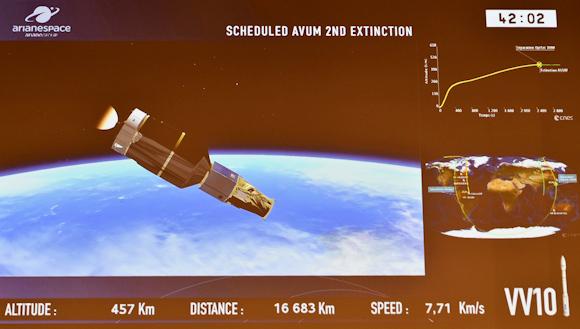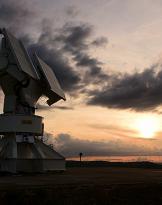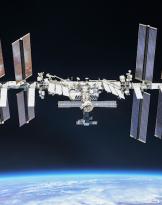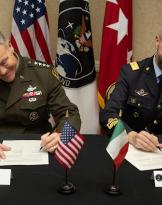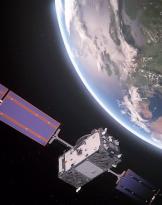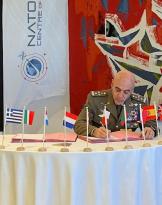"Ten seconds to launch" and ... Optsat 3000, the new gem of the Italian Ministry of Defense and Industry, rises high among the stars. They are the 3.58 of the 2 August. The base, that of Kourou, in French Guyana. After 42 minutes, the satellite releases from the European launcher Vega, made by Avio and the tenth mission accomplished successfully.
Optsat 3000 is a national defense strategy program, but it can also be used in a dual way to monitor and manage emergencies, such as natural disasters such as floods, fires or earthquakes, and humanitarian emergencies. Fifteen hundred pounds of weight, a length of 4,5 meters, the satellite is optical readout and azoresynchronous orbit, capable of returning to the same point at the same time, can scrutinize precisely millimeter details elsewhere little sharp. It is clear that in an historic moment of terrorism and with the Italian contingents in many parts of the world, it will be a very useful defense tool and will allow Italy a national autonomy to observe land from space.
Optsat 3000 was officially presented on the morning of 2 August in the new headquarters of the General Secretariat of Defense and National Directorate of Armaments in Centocelle, in Rome. To do the honors, the general secretary of defense and national director of armaments gen.sa Carlo Magrassi, the CEO of Leonardo Company Alessandro Profumo, the chief of staff of defense gen. Claudio Graziano, and the Undersecretary of State for Defense Gioacchino Alfano, representing the Minister Roberta Pinotti, engaged in Parliament.
Optsat 3000 is a complete satellite earth observation program, strongly supported by the Ministry of Defense, which also sees the cooperation of the Israeli Defense Ministry, carried out by Israel Aerospace Industries with the central role of Italian industry, given that the entire system is supplied by Leonardo through Telespazio-Thales. The satellite, now undergoing checks and tests, will be managed entirely by the Italian land segment, on three operating sites: the Joint Satellite Remote Sensing Center (CITS) of Pratica di Mare, the Sicral management and control center in Vigna di Valle, both near Rome and Telespazio's Fucino Space Center (L'Aquila). From 2018 Optsat 3000, which will be fully operational in December and is expected to be seven years old, will cross-reference its optical data with the radar data of Cosmo SkyMed second generation, providing important elements also for the operation of the Defense.
 The satellite is a synergy between the military world and the defense industry. "Through the initiative of Optsat 3000 there is a further piece that is added to the already advanced capabilities of the Defense in the field of Earth observation from space, achieved with previous programs starting from 2007 (Cosmo-Skymed 1) and the next two years will be renewed with the launch of second-generation satellites"He explained January Carlo Magrassi, Secretary General of Defense and National Armaments Director.
The satellite is a synergy between the military world and the defense industry. "Through the initiative of Optsat 3000 there is a further piece that is added to the already advanced capabilities of the Defense in the field of Earth observation from space, achieved with previous programs starting from 2007 (Cosmo-Skymed 1) and the next two years will be renewed with the launch of second-generation satellites"He explained January Carlo Magrassi, Secretary General of Defense and National Armaments Director.
"The satellite launched today into orbit with its optical sensor, the result of the consolidated cooperation relations in the defense field between Italy and Israel, complements the high performance observation capabilities based on Sicral synthetic technology, another tangible sign of the importance that the Defense attributes to the domain of space. And the support that this guarantees to the correlated industrial sector, decidedly niche, is significant. As is known to those who work in the sector, the Italian Ministry of Defense together with our space agency Asi, has always proudly played a leading role in the aerospace field, since its origins. Today's is undoubtedly another important step in the long journey that from the distant December 1964, the date on which Italy became the third nation to put its own satellite into orbit thanks to the efforts of pioneers led by gen. Luigi Broglio, saw our nation acquire military but also dual assets of strategic value and undoubted technological value, with specific reference to the field of telecommunications, observation and space. It goes without saying that these assets, due to their institutional and dual nature, constitute a resource for the entire country and that the dicastery makes available to other institutions operating in the context of security and for the management of emergencies of any kind, such as, for example, the monitoring of the territory in the event of natural disasters (floods, forest fires, earthquakes), as is also strongly referred to in the International and Defense White Paper on Security ”.
 "In the last thirty years the geostrategic scenarios have radically changed and the ways in which modern operations are conducted require an increasing use of satellite services, which become fundamental force multipliers in the exercise of command and control of operational units, even if deployed at a great distance from the motherland and in various terrestrial and maritime theaters. Following the new trends, Italy has decided to invest significantly in these capabilities by launching, in 2001, the adoption of a military and strategic satellite communications program, the Sicral program which today sees, in space, a "confederation" of 3 of our geostationary satellites followed in 2007 by the creation, in cooperation with ASI, of the Cosmo SkyMed earth observation program, with four satellites in low orbit ... space is also monitored to avoid collisions between satellites, thanks to a collaboration with the United States and the European Union.
"In the last thirty years the geostrategic scenarios have radically changed and the ways in which modern operations are conducted require an increasing use of satellite services, which become fundamental force multipliers in the exercise of command and control of operational units, even if deployed at a great distance from the motherland and in various terrestrial and maritime theaters. Following the new trends, Italy has decided to invest significantly in these capabilities by launching, in 2001, the adoption of a military and strategic satellite communications program, the Sicral program which today sees, in space, a "confederation" of 3 of our geostationary satellites followed in 2007 by the creation, in cooperation with ASI, of the Cosmo SkyMed earth observation program, with four satellites in low orbit ... space is also monitored to avoid collisions between satellites, thanks to a collaboration with the United States and the European Union.
The space environment also provided the opportunity to extend the scope of international co-operation, allowing our national industry to produce more satellites in joint ventures, including the most important with France, the realization of the two satellites for communications respectively military and dual Sicram 2 and Athena Fidus.
Among the international collaborations is also the realization of the Optsat 3000 satellite produced by Israel Aerospace Industries, which in less than 400 kg of weight embarks a technologically advanced optical sensor. In terms of performance, it is capable of acquiring high resolution optical images on a global scale, with surprising shooting agility. This new national capacity joins, in the optical sector, that guaranteed by the French satellites of the current Elios family and others to be built in the future, as part of the historic collaboration based on the exchange of reciprocal optical-Saar services with France. And, thanks to the developments made by the national industry for the user segment, it integrates with those of the radar satellites of the Cosmo SkyMed family, the flagship of our industry ”.
"Today, with the launch of the Optsat 3000 satellite from the Kourou base in French Guiana, we are witnessing an important achievement for the Italian aerospace industry, a success we are particularly proud of and which is a demonstration of the excellent industrial and technological capabilities. of our country ", Leonardo's CEO made his debut Alessandro Profumo.
 "Telespazio, as prime contractor, is in fact responsible for supplying the entire system, from the satellite, from the Israeli Iai, to the ground segment, from launch and launch services to the preparation and execution of operational and logistic activities, up to the in-orbit tests of commissioning. The launch was instead carried out with the Vega carrier, the flagship of the national industry and today reached its tenth mission. As CEO of Leonardo I want to express a particular thanks to all the skills and professionalism that have contributed to the Optsat 3000 program which, thanks to the supply of high resolution optical images of every area of the planet, will allow Italy to acquire an autonomous national capacity observation of the earth from space. The program is a further demonstration of the fruitful collaboration with the Italian Defense, with which important projects have been carried out over the years. I am referring (as already mentioned by Gen. Magrassi) to the Sipram military communications system for which 3 satellites have already been launched and to Kosmo Sky Mer with 4 radar satellites for earth observation already in orbit and two of the new generation. , under construction, which will be integrated with Optsat 3000.
"Telespazio, as prime contractor, is in fact responsible for supplying the entire system, from the satellite, from the Israeli Iai, to the ground segment, from launch and launch services to the preparation and execution of operational and logistic activities, up to the in-orbit tests of commissioning. The launch was instead carried out with the Vega carrier, the flagship of the national industry and today reached its tenth mission. As CEO of Leonardo I want to express a particular thanks to all the skills and professionalism that have contributed to the Optsat 3000 program which, thanks to the supply of high resolution optical images of every area of the planet, will allow Italy to acquire an autonomous national capacity observation of the earth from space. The program is a further demonstration of the fruitful collaboration with the Italian Defense, with which important projects have been carried out over the years. I am referring (as already mentioned by Gen. Magrassi) to the Sipram military communications system for which 3 satellites have already been launched and to Kosmo Sky Mer with 4 radar satellites for earth observation already in orbit and two of the new generation. , under construction, which will be integrated with Optsat 3000.
In addition, this program is another testimony to the solidity of the collaboration between Italy and Israel in the field of defense and, for the first time, focused on a satellite program. It's a success we celebrate together, industry and defense, in an increasingly crucial industry. Space, in fact, is a strategic element for the growth of the political, economic and technological weight of the most advanced countries. In Italy, with 6mila employees and revenues of over 1,6million euros, which when calculated the whole chain rises to around 3milliard, the space sector is a top-ranking reality in the national economy. The quantitative dimension, however, does not fully reflect the importance of the sub-fund, considering that every euro invested in space generates more than three proceeds.
At an industrial level, in our country, our companies have played a leading role since 64. Today Leonardo guarantees Italy a complete space supply chain: satellites, launchers, terrestrial sector for data management. Thanks to these skills and competences, we participate in the most important international space programs, our leadership is also expressed by places of excellence such as Telespazio's Fucino space center, recognized as the most important in the world for civil uses. We strongly believe in the space sector, which represents the frontier of innovation for every country. Our commitment as an industry is to continue investing in research and development for ever more advanced technologies. Today, in particular, we are working on the development of the second phase of Cosmos SkyMed, which will guarantee a generational leap in technology and performance ”.
The comment of the ad of Telespazio has been added to the Perfume Luigi Pasquali, which reiterated as "that with the Italian and Israeli Defense Ministries is a full, high-level collaboration of concreteness, effectiveness and determination".
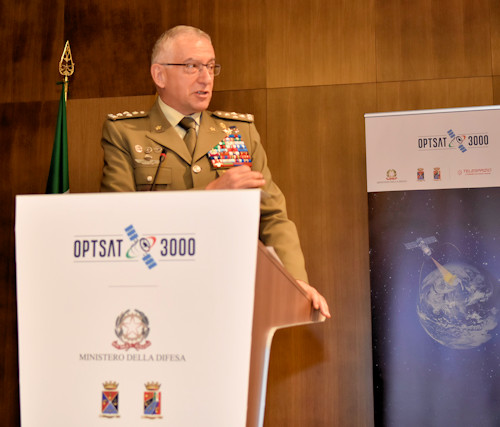 "At a time like this in which we have many ongoing operations around the world and new and consolidated threats and threats, the need for collaboration with friends and allies is becoming increasingly important and increasingly significant, as it was also written in the White Paper"The Reflection of Defense Chief of Staff January Claudio Graziano.
"At a time like this in which we have many ongoing operations around the world and new and consolidated threats and threats, the need for collaboration with friends and allies is becoming increasingly important and increasingly significant, as it was also written in the White Paper"The Reflection of Defense Chief of Staff January Claudio Graziano.
"Trying to have a vision of operational planning and consequent industrial planning for future activities, such as that which has taken place in Guyana's base, in cooperation with Israel and with partners and industry, is of great significance because obviously the role that playing a country depends on the real capabilities it can express and how it is placed in the international arena, both from the point of view of operational and industrial effectiveness in this complex world.
From an operational point of view, we talk about it all the time: today, if you don't have information and knowledge, if you don't have the vision, if you don't have the data and the ability to exploit it, you are not in a position to operate. In this multi-layered cybernetic spatial dimension, Optsat 3000 is inserted into a fundamental element, with the collection of images in real time and a flexibility that will allow us, from an operational point of view, to have the necessary tools to manage safely. our operations.
From Optsat 3000 there are other information, which must be connected to a system and multiple reading elements that must be protected, because these are also subject to cybernetic war and the possibility of interference and one can imagine how delicate this theme can be. Evidently, not only a defense system is needed, but also that of internal security and the general commanders present can understand that dual use, geostationary knowledge of the terrain and updates on evolution and changes have a particular feedback also on internal security. And I add the importance with regard to emergencies and natural disasters, where real-time updating is crucial. The FF.AA are constantly engaged in this and will be in the future and these data will be essential to provide better help to our people. I agree with what was said by Alessandro Profumo, on the importance of this military investment to create work and security and also synergy for the interests of Italy, which are the security of the country and the economic development of our country. Also considering that today the operations are not just interforce but inter-agency, which exchange data with all the other institutions ".
 "Today I am excited ... This is a country that in addition to being excellent - and the launch is a demonstration - maintains its capabilities at high levels and this happens when we turn to those who are capable"The observation of the Under Secretary of State for Defense Gioacchino Alfano, representing Roberta Pinotti, Minister in the Parliament.
"Today I am excited ... This is a country that in addition to being excellent - and the launch is a demonstration - maintains its capabilities at high levels and this happens when we turn to those who are capable"The observation of the Under Secretary of State for Defense Gioacchino Alfano, representing Roberta Pinotti, Minister in the Parliament.
"We have large universities, excellent research institutes, we have relationships with all world partners ... General Graziano referred to dual use ... it seems easy to say that we must invest in national security but we must also think about different uses ... Today when planning defense investments, you have to do it from the start. The first mission of politics is to know how to interpret the things that are done, regardless of the legislature. The second is to understand that, beyond the available resources, one must never give up on investing and supporting an Italian reality. The third: we are a country made up of regions and industrial policy also maintains regional support, which however must be protagonists, in different positions, in this type of approach. I charge Optsat 3000 with all these meanings ... Of the Italian companies I meet, of those that invest in this sector, I was struck by the fact that the owners called the individual employees by name, that the Italian company, excellent in this sector, considers the human resource the most important thing ...".
"...Optsat 3000 is a military program but each space defense program is also a dual capability because, just as it is used to support military operations between communications, earth observation and intelligence, the same resources are made available to the institutions in case of emergencies. If the country calls, the Defense responds". The team admiral Ruggero di Biase, Director IV Department of the General Secretariat of Defense / National Directorate of Armaments, clarifies some doubts about Optsat 3000.
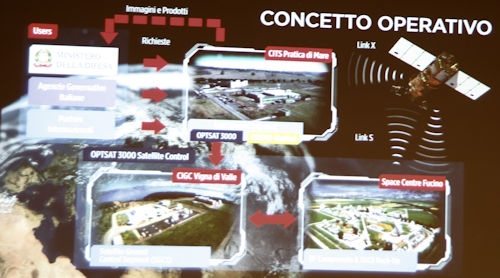 Dual capacity of Optsat: this is because the Defense is also more and more civil protection, as we have seen recently in the earthquake in central Italy, where the Armed Forces have collaborated with firefighters?
Dual capacity of Optsat: this is because the Defense is also more and more civil protection, as we have seen recently in the earthquake in central Italy, where the Armed Forces have collaborated with firefighters?
More and more civil protection, intervenes in support of emergencies, the Army sided with floods or earthquakes, the Navy is arrayed for refugees, the Air Force has observational structures and participates, in this context, the gathering of information. And information is conveyed to those who must operate in these emergency situations but also in support of security forces, with whom we already collaborate.
The synergies are also international, as the Optsat 3000 was built in collaboration with Israel ...
We chose Israel because we consider it a valid partner and because it was part of a wider cooperation: there is capacity exchange, mutual buying of systems. They took, for example, training aircraft because they decided that our product was niche and we, who needed their capability, were looking for a requirement to incorporate an optical satellite into the Earth observation radar system as well. So there was a balanced exchange between the two nations in the context of a cooperation we had already.
Cooperation that Israel also serves because of its role in the Middle East?
Sure. Italy considers a good partner. Politically they see us as one of the countries that can bring them to Europe, they have a privileged relationship with us.
Did other countries also collaborate on the project?
Poland has joined, like Finland. They are participating in these programs and buy services from us. Which means that we also enjoy trust from European partners. Obviously there is a financial and economic return for the country.
How much has the Optsat 3000 project cost?
It cost around 200 millions of euros.
We speak of a satellite that collects double use information but also and above all for security. Obviously, was also a defense system in the event of a cyber attack, given that the "war" is more and more computer science?
Everything digital is now subject to attack. The analog world was much more protected, the digital one is much more vulnerable. It is clear that we are equipping ourselves with cyber defense capabilities in the event of a cyber attack, to protect our data. Today every capacity should be born and designed and planned with cyber embedding structures. It is a fundamental step in the development of the new systems.
Stanislav Petrov, in the 1983 Lieutenant Colonel of the Red Army, received the alarm of a US nuclear attack on the USSR. It was an error started by Krokus, a very advanced computer system for the time. Petrov had doubts, did not obey orders and did not operate the nuclear response button, saving the world. Is there no danger that these satellite systems, today more than yesterday, could have a flaw, or a hack and create the same problem?
Petrov saved the world. And since then it was understood that it was the case to think about it. More and more, many of the investments will go in this direction. And defense capabilities, even in this role, with the experience and the knowledge of the staff working in the field, are made available to the institutions.
(images: SMD / Telespazio / Author)

